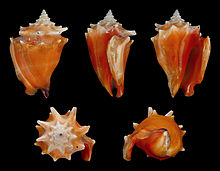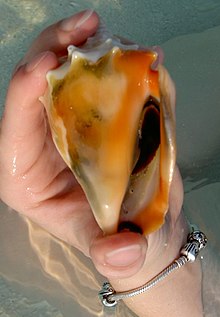Strombus pugilis
| Fighting conch | |
|---|---|

| |
| Five views of a shell of Strombus pugilis | |
| Scientific classification | |
| Domain: | Eukaryota |
| Kingdom: | Animalia |
| Phylum: | Mollusca |
| Class: | Gastropoda |
| Subclass: | Caenogastropoda |
| Order: | Littorinimorpha |
| Family: | Strombidae |
| Genus: | Strombus |
| Species: | S. pugilis
|
| Binomial name | |
| Strombus pugilis | |
| Synonyms | |
| |
Strombus pugilis, common names the fighting conch and the West Indian fighting conch, is a species of medium to large sea snail, a marine gastropod mollusk in the family Strombidae, the true conchs.
S. pugilis is similar in appearance to Strombus alatus, the Florida fighting conch.
Shell description
[edit]
The maximum recorded shell length is 110 mm[1] or up to 130 mm,[2] commonly to 90 mm.
Like other species in the same genus, Strombus pugilis has a robust, somewhat heavy and solid shell, with a characteristic stromboid notch. It has a well-developed body whorl and a short and pointed spire. It presents 8 to 9 whorls,[3] each of them having a single row of subsutural spines, becoming larger towards the last whorl.[2] These spines, however, may be less conspicuous or even absent in some populations.[4] Its aperture is relatively long and slightly oblique.[3] The posterior angle of the outer lip is distinct, projecting in the posterior direction in an erect fashion.[5] The operculum is sickle-shaped, similar to several other Strombus snails.
The shell color varies from salmon-pink,[3] cream or yellow to light or strong orange, and the interior of the aperture is usually white. The anterior end presents a dark purple stain,[2] which is one of the diagnostic characters of this species, and is absent in Strombus alatus.
This species is closely similar to Strombus alatus, which has a more northerly range. Strombus alatus shells have less prominent subsutural spines and a slightly more projected outer lip. Some scientists have treated the two as distinct species; others as subspecies.[6] In an extensive study of the Stromboidea in 2005, Simone provisionally treated them as distinct species, but observed that "no spectacular morphological difference was found [and] all related differences, even those of the genital system, can be regarded as extreme of variation of a single, wide distributed, variable species."[7]
Distribution
[edit]Strombus pugilis lives in Bermuda, southeastern Florida, the Caribbean Sea, and south to Brazil.[2]
Phylogeny
[edit]| Phylogeny and relationships of Eastern Pacific and Atlantic Strombus species, according to Latiolais et al. (2006)[8] |
A cladogram based on sequences of nuclear histone H3 gene and mitochondrial cytochrome-c oxidase I (COI) gene showing phylogenetic relationships of (32 analyzed) species in the genus Strombus and Lambis, including Strombus pugilis, was proposed by Latiolais et al (2006).[8] In this hypothesis, Strombus pugilis and Strombus alatus apparently share a common ancestor, and are possibly close related.[8]
Ecology
[edit]Habitat
[edit]This sea snail lives on sandy and muddy bottoms,[2][4] from the intertidal zone[4] to depths between 2 and 10 m.[5]
The minimum recorded depth for this species is 0 m; the maximum recorded depth is 55 m.[1]
Life cycle
[edit]During a long period in the initial stages of its development, the Strombus pugilis larvae feed mainly on plankton.[2] Studies indicate that some populations of Strombus pugilis may reproduce throughout the year.[9]
Reproduction orgies have been observed, on silty sand at 8-10 m. depth,
with egg cases littering the bottom, and obvious copulation in progress across a fairly large area.
Feeding habits
[edit]Strombus pugilis is known to be a herbivore, feeding on plants and algae.[10]
Human uses
[edit]The flesh of Strombus pugilis is edible.[3] It is usually cooked by boiling, and is consumed by local fishermen.
Strombus pugilis is used as a zootherapeutical product for the treatment of sexual impotence in the traditional Brazilian medicine of the Northeast region of Brazil.[11]
The shell is commonly used as a decorative item and is sold in local markets as a souvenir.
References
[edit]- ^ a b Welch J. J. (2010). "The "Island Rule" and Deep-Sea Gastropods: Re-Examining the Evidence". PLoS ONE 5(1): e8776. doi:10.1371/journal.pone.0008776.
- ^ a b c d e f Leal, J.H. (2002). Gastropods. p. 99-147. In: Carpenter, K.E. (ed.). The living marine resources of the Western Central Atlantic. Volume 1: Introduction, molluscs, crustaceans, hagfishes, sharks, batoid fishes, and chimaeras. FAO Species Identification Guide for Fishery Purposes and American Society of Ichthyologists and Herpetologists Special Publication No. 5. 1600p.
- ^ a b c d Rios, E. C. (1994). Seashells of Brazil (2nd ed.). Rio Grande: FURG. ISBN 85-85042-36-2.
- ^ a b c Simone, L. R. L. (2005). "Comparative morphological study of representatives of the three families of Stromboidea and the Xenophoroidea (Mollusca, Caenogastropoda), with an assessment of their phylogeny". Arquivos de Zoologia. 37 (2). São Paulo, Brazil: Museu de Zoologia da Universidade de São Paulo: 141–267. doi:10.11606/issn.2176-7793.v37i2p141-267. ISSN 0066-7870.
- ^ a b Cervigón, F. et al. (1993): FAO species identification sheets for fishery purposes. Field guide to the commercial marine and brackish-water resources of the northern coast of South America. Rome, FAO. 513 p.
- ^ Simone (2005): Comparative Morphological study of representatives of the three families of Stromboidea and the Xenophoroidea (Mollusca, Caenogastropoda), with an assessment of their phylogeny Archived 5 March 2012 at the Wayback Machine, p. 142.
- ^ Simone (2005): Comparative Morphological study of representatives of the three families of Stromboidea and the Xenophoroidea (Mollusca, Caenogastropoda), with an assessment of their phylogeny Archived 5 March 2012 at the Wayback Machine, p. 169.
- ^ a b c Latiolais J. M., Taylor M. S., Roy K. & Hellberg M. E. (2006). "A molecular phylogenetic analysis of strombid gastropod morphological diversity". Molecular Phylogenetics and Evolution 41: 436-444. doi:10.1016/j.ympev.2006.05.027. PDF.
- ^ Cardenas, E.B., D. Aldana Aranda, and G. Martínez Olivares. (2005). Gonad development and reproductive pattern of the fighting conch Strombus pugilis (Lineé, 1758) (Gastropoda, Prosobranchia) from Campeche, Mexico. Journal of Shellfish Research 24(4):1127-1133.
- ^ Robertson, R. (1961). The feeding of Strombus and related herbivorous marine gastropods. Natul. Nat. 343: 1-9
- ^ Alves R. R. N. 2009. Fauna used in popular medicine in Northeast Brazil. Journal of Ethnobiology and Ethnomedicine 2009, 5:1. doi:10.1186/1746-4269-5-1. The species is incorrectly spelled in the reference as Strombus puginis.
- Rosenberg, G., F. Moretzsohn, and E. F. García. 2009. Gastropoda (Mollusca) of the Gulf of Mexico, pp. 579–699 in Felder, D.L. and D.K. Camp (eds.), Gulf of Mexico–Origins, Waters, and Biota. Biodiversity. Texas A&M Press, College Station, Texas.
